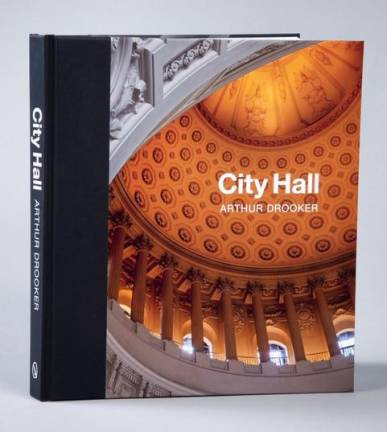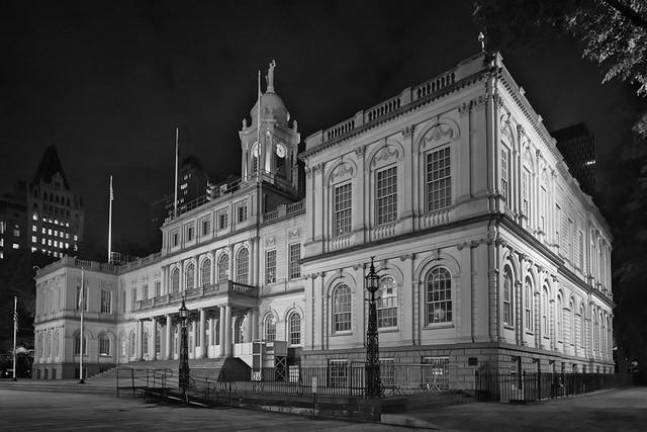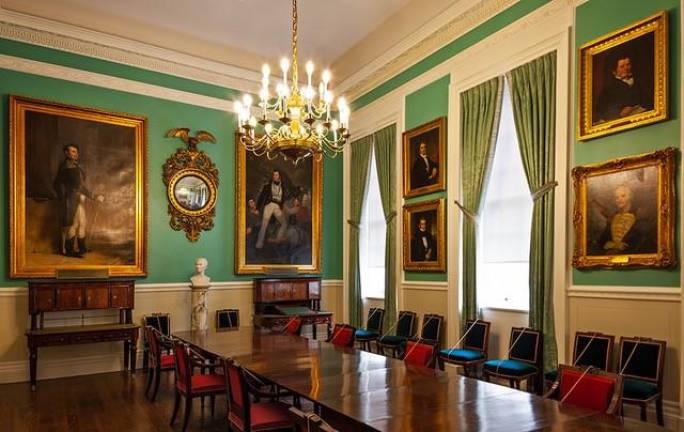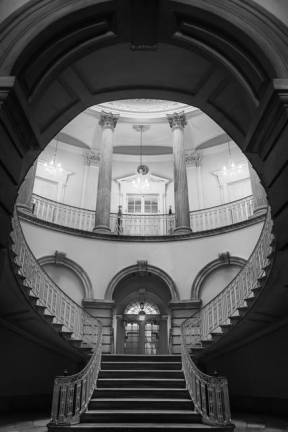City Halls Celebrated
Photographer Arthur Drooker calls his new book “a manifesto on behalf of democracy”




Think of all the bad raps City Hall gets: “You can’t fight it.” It’s where our local representatives fight over budgets and crimes small and large. Going to the one nearest you may feel like getting called to the principal’s office.
But how many of us actually stop to look around at the buildings themselves? Well, photographer Arthur Drooker (“American Ruins, “Conventional Wisdom”) spent five years doing just that and his new book — called “City Hall” — is a beauty. (“A masterful exercise in civic engagement and patriotic reconsideration,” writes Douglas Brinkley in the Foreward.) The New York Times recently put it on its New and Noteworthy Visual Books list.
Not only are the photos lovely, but the history and architectural feats behind Drooker’s chosen sites make for a fascinating read. And after watching our nation’s Capitol attacked and damaged, it seems an apt time to recall and appreciate these places.
This was a taxing but enlightening process for Drooker, a former New Yorker (he attended Horace Mann), now mostly living in the Bay Area. “I began working on the book in 2016 and envisioned it mainly as a photographic appreciation of under-recognized civic buildings,” he says. “Over time, as the country became bitterly divided, I saw the book become in its own way a manifesto on behalf of democracy. The storming of the Capitol made it tragically clear how precious our form of government is and that the places where we conduct the ‘people’s business’ symbolize the ideals and principles we hold dear.”
“The Grande Dame”
Yes, New York made the list. Twice. The city’s federalist-style building downtown is, in fact, the first in the book, called the “The Grande Dame.” Who knew that 26 firms entered a design competition, and the winning team (white marble floating staircase and all) earned a whopping $350. One of the architects, John McComb, Jr. had built Alexander Hamilton’s home and Gracie Mansion. (His name appears on the cornerstone, laid in 1803.) Construction had several delays, including labor disputes and a yellow fever outbreak. City Hall officially opened in 1812 at a final cost of $538,000.
Perhaps surprisingly, the other City Hall of the state that is ranked is Buffalo’s. “It stood out immediately because it so clearly is one of the best examples of art deco architecture in the country,” explains Drooker. “Its stepped, soaring verticality, and extraordinary tile work, murals and friezes, make it truly special. Its lobby and council chamber are among my favorite civic spaces in the book. Architect John Wade was intent on designing a building that celebrated the city on its centennial (1932) and he succeeded.”
Clearly, Drooker did his research, before finalizing the list which also includes Palm Springs, Cincinnati, Los Angeles, San Francisco, Las Vegas and St.Paul, among others. Finishing the book, one might have an immediate desire to get in a van and do a City Hall tour of the U.S.
All along, he got grateful support and assistance from the various halls. “I received extraordinary cooperation from the folks at New York City Hall,” he says. “I first reached out to Keri Butler, the acting executive director of the NYC Public Design Commission. She in turn put me in touch with Mary Beth Betts, the in-house historian there. Both of them were wonderful to work with. In the case of Buffalo City Hall, I reached out to everyone from the maintenance department to an independent historic preservation group. It took a while to secure permission to photograph the interior of the building, but once I did, it was smooth sailing. I even got to interview Mayor Byron Brown.”
A book like this reminds us of the care and creative commitment that goes into some of our most famous — yet, often forgotten — buildings. Maybe you can’t fight City Hall, but it may be time to stop by and appreciate its splendor.